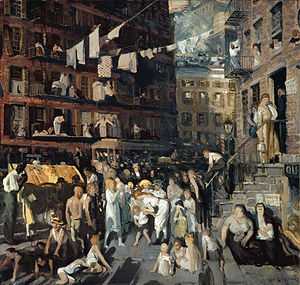Cliff Dwellers (painting)

Cliff Dwellers (1913) is a painting by George Bellows. It is an oil on canvas painting, 401⁄4 by 421⁄8 inches. Bellows exhibited the work in the 1913 Armory Show, which he helped organize. The painting is currently in the collection of the Los Angeles County Museum of Art. In Cliff Dwellers, George Bellows captures the colorful crowd on New York City’s Lower East Side. It appears to be a hot summer day. People spill out of tenement buildings onto the streets, stoops, and fire escapes. Laundry flaps overhead and a street vendor hawks his goods from his pushcart in the midst of all the traffic. In the background, a trolley car heads toward Vesey Street.
Formal Analysis
Shadowing is evident throughout this painting as make out the distance of each building based on the light and dark shade of each one. This also helps make the crowd seem deeper than we can actually see. The perception of such a large crowd contrasts with the immediate foreground, which leads our eye specifically to the subjects in this area and therefore displaying their significance to this painting. Looking further into the composition of Cliff Dwellers specifically in the system of colors used, The Paintings of George Bellows”, a commentary on most of Bellows’ work, states that:
“Bellows continued to use Maratta’s system to select the palettes of the paintings through 1913… Cliff Dwellers, painted in May 1913, was the exception, representing his most complex exploration of the Maratta color system.” [1]
The significance of Bellows’ willingness to stray away from his usual system of color and choose a more monochromatic scale of colors, shows the audience how unique this piece of art is and how it differs from all other works not only in subject or theme but also in color.
Historical Context
The painting, made in 1913, suggests the new face of New York. Between 1870 and 1915, the city’s population grew from one-and-a-half to five million, largely due to immigration. Many of the new arrivals—Italian, Jewish, Irish, and Chinese—crowded into tenement houses on the Lower East Side—the area north of the Brooklyn Bridge, south of Houston Street, and east of the Bowery. Among them were thousands of Eastern European Jews, who found temporary or permanent shelter along streets such as East Broadway, the setting for Cliff Dwellers. The city had never seen this kind of density before.
Within the context of Cliff Dwellers the audience is able to convey a sense of congestion, overpopulation and (primarily seen in the foreground) the impact of the city among the youth. Within the book, The Paintings of George Bellows a historical account of how adamant “urban reformers” were during the early twentieth century as thousands of immigrants migrated to neighborhoods of New York. “The children in Bellows’s Cliff Dwellers, innocent as they appear, exhibited no effects of the requisite “Americanizing” process urban reformers considered crucial to the maintenance of social order.” [2]
Paired with the scrutiny heaped upon immigrants was the fact that they were made to live in conditions, which were made unbearable by the toll of industrialization within these areas. Small and dense were the living quarters of many who worked in similar environments in factories. Small, dense, dark, which can easily be seen within the painting and helps promote the idea of how industrialization has impacted the working class lifestyle.
New York Realists were called by critics as the "revolutionary black gang" and the "apostles of ugliness." A critic, referring to their depictions also conferred them the pejorative label Ashcan School which became the standard term for this first important American art movement of the 20th century.
References
- American Realism, Gerry Souter, 1991, p. 110,
- George Bellows and Urban America, Marianne Doezema, 1992, Yale University Press, p. 195,
- The Paintings of George Bellows., Young, Mahonri, Sharp and George Bellows, 1973, New York: Watson-Guptill Publications.